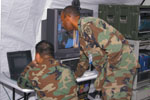Internet Protocol Key To Smaller, Lighter Communications Devices
 |
| Maj. Gen. Conrad Ponder, USA (r, fore-ground), chief integration officer, chief information officer/staff officer for communications (G-6), Office of the U.S. Army, and Capt. Ray Phariss, USA (3rd from l), executive officer, chief information officer, G-6, Office of the Army, are briefed by Joint Communications Support Element (JCSE) members Sgt. 1st Class Steven E. Hammond, USA (l), transmission program manager, joint staff officer for plans (J-5); Lt. John C. Wilkerson, USN (2nd from l), deputy J-5 and senior program manager; and 2nd Lt. Kent Ridl, USAF (r), joint staff officer for operations, assistant officer in charge, JCSE planning team. |
Members of the joint community are moving forward on proving that voice over Internet protocol can be a force multiplier. Although voice over Internet protocol is still in relative infancy, the Joint Communications Support Element, U.S. Joint Forces Command, has demonstrated through a series of exercises that this approach can increase both technological advances and bandwidth efficiency provided to the joint warfighter. It also decreases airlift requirements, reduces the number of needed personnel and cuts the cost of communications systems by moving from circuit-based to Internet-based networks.
Two of the Joint Communications Support Element’s (JCSE’s) major lessons learned from operations Enduring Freedom and Iraqi Freedom were the inefficiency of traditional network bandwidth allocations and the shortage of airlift availability. To address these issues, the element, which is located at MacDill Air Force Base, Florida, created a plan to migrate to everything over Internet protocol (EoIP) networks. These networks eliminate the need for circuit-based multiplexing and route all communications services using convergence routers through a time division multiple access (TDMA) IP satellite modem. The modems and convergence routers work together to allocate bandwidth dynamically to the service that needs it most. Traditional networks using fixed-circuit data rates, frequency division multiple access (FDMA) satellite links and analog voice systems severely limit customers’ flexibility to change communications services and bandwidth allocations.
According to a briefing on emerging IP network-centric requirements conducted by the Joint Chiefs of Staff/Command, Control, Communications and Computer Systems Support Division (J-6C), TDMA satellite modems create a 2-to-1 ratio increase in the efficiency of communications service allocations. As a result, a properly configured EoIP network results in a pool of available bandwidth, ensuring better use of satellite resources.
Last August, the JCSE developed a plan to employ EoIP networks operationally within 90 days. The plan used three scheduled exercises: the JOINT USERS INTEROPERABILITY COMMUNICATIONS EXERCISE (JUICE) 04, coalition exercise COBB RING (CR) 04 and the Army Regimental Signal Symposium (ARSS) 04. These exercises allowed the unit to employ a crawl-walk-run technique for the migration to EoIP by setting goals for each exercise that built on previous successes. ARSS 04, which took place in December, was the culminating event that marked the U.S. Defense Department’s first use of the EoIP architecture from a Defense Information Systems Agency (DISA) teleport to a tactical communications unit.
The Communications-Electronics Command sponsors JUICE annually. The exercise provides a forum to test the department’s communications interoperability issues. For JUICE 04, the mission was to provide tactical IP-converged services for a joint task force (JTF) wide area network supporting a JTF and the component commands. The JCSE’s overall goal was to validate the concepts of EoIP technology and to design an equipment configuration that would satisfy the tactical customer’s communications needs.
During the exercise, the JCSE assessed several different IP equipment configurations while evaluating interoperability with traditional networks. The element also tested functionalities over an IP network such as secure telephone unit/secure telephone equipment (STU/STE) media adapters, IP private branch exchange telephony systems, IP satellite modems and diagnostic equipment. The network comprised three TDMA IP satellite links through a single convergence router using an STU/STE media adapter to provide Defense Switched Network (DSN) and secure voice traffic over IP. At the conclusion of JUICE 04, the first goal in the migration process was accomplished: A validated equipment configuration that provided IP bandwidth efficiency and supplied secure DSN voice service via IP over a TDMA satellite link was achieved.
The element’s next step was to prove that the IP equipment configuration, validated during JUICE 04, would support a live, operational network with customers. The mission for CR 04, which was held in November, was to support a coalition JTF. CR 04 is a biannual, multinational exercise designed to test interoperability between the JCSE and its coalition counterparts, including the United Kingdom’s 30th Signal Regiment and the Canadian Forces Joint Signal Regiment. The Canadian Forces were unable to participate in CR 04 because of operational commitments.
The network was designed to highlight the versatility of IP solutions by showcasing how circuit-based and IP networks can interface. The JTF hub network drew Defense Information Systems Network (DISN) services from a DISA standardized tactical entry point site via circuit-based networking. The JTF hub’s convergence router introduced the services into the IP portion of the network. The IP network was extended to small command and control (C2) sites, one via TDMA IP and one via an FDMA satellite connection utilizing commercial and Defense Satellite Communications System (DSCS) bandwidth. By using traditional X-band satellite communications, the JCSE was able to demonstrate that IP convergence multiplexing will work over an FDMA satellite network. Current constraints in modeling and monitoring of bandwidth prevent IP satellite modem use over the DSCS network. Therefore, at this time, greater bandwidth efficiency is gained in a true EoIP network using a TDMA IP satellite modem and commercial satellites.
Along with a continued assessment of the IP equipment configuration and convergence routing, CR 04 objectives included successfully deploying two C2-enhancing IP services—the Combined Enterprise Regional Information Exchange System (CENTRIXS) and Collaboration Information Environment (CIE)—to the coalition customer. CENTRIXS is the leading data system enabling information sharing between coalition forces in support of military operations. CIE is a shared information environment that encourages more efficient management of critical information, data repositories and resources, which increases the effectiveness of military staffs. CENTRIXS and CIE have proved to be essential C2 resources during operations Enduring Freedom and Iraqi Freedom. The JCSE connected to the Joint Forces Command to draw its first-ever tactical connection to the CENTRIXS Global Counter Terrorism Force and used an IP convergence network to provide the CENTRIXS as well as a CIE tool to two small C2 sites.
Proving the size and cost benefits of IP networks was one of the greatest successes of CR 04. The communications equipment needed to support a small C2 site usually requires three aircraft pallets, but by using the EoIP approach the required equipment could be deployed to the United Kingdom in only three transit cases that were shipped via FedEx. The IP site in the United Kingdom provided the same voice, data and video services while using a U.K. satellite terminal.
The reduction in the physical footprint allowed the element to decrease the number of required personnel by half from eight to four system operators. JCSE personnel anticipate that the implementation of EoIP networks will converge military operational specialties and reduce training requirements, the logistics tail, infrastructure and the number of equipment maintenance personnel required.
 |
| Sgt. Robert Vongsalat, USA (l), and Staff Sgt. Kenneth U. Foddrell, USA, both network administrators with the 1st Joint Communications Squadron, JCSE, work with the theater injection point and an Internet protocol videoconferencing bridge on the global broadcast system. |
The ARSS 04 marked the culminating event in the JCSE’s migration to EoIP networks. To date, units have been unable to draw services via IP from DISA. The objective of the ARSS 04 was to establish an EoIP network, which included drawing DISN services from a DISA teleport directly via IP. The element worked closely with DISA headquarters to obtain a waiver to permit the temporary installation of a TDMA IP satellite modem, convergence router, STU/STE media adapter and an IP encrypter for a total equipment cost of $50,000 to transform the Northwest Teleport into an IP-capable point of presence. The JCSE hub site at Fort Gordon in Georgia used a TDMA IP hub modem to establish an EoIP network with the Northwest Teleport and two small C2 sites. The power and flexibility of IP technology are amplified by using a TDMA IP satellite hub modem that can terminate up to 2,000 remote IP sites on a single commercial satellite link.
The successful EoIP transformation of a DISA teleport facility during the ARSS 04 demonstrated that EoIP is plausible and can be accomplished today with relative ease. EoIP networks serve as a combat multiplier by removing the rigidity currently associated with circuit-based FDMA networks. The EoIP architecture is easily scalable, extremely flexible and cost-efficient, and it enables the warfighter to tailor networks to meet ever-changing needs with less cost, a smaller footprint and fewer equipment operators at a moment’s notice.
The move toward EoIP is ongoing for the JCSE. In January 2005, the element implemented its first real-world extension site in support of operation Enduring Freedom using solely IP equipment. By September 2005, the JCSE intends to complete the migration of its small C2 packages to IP. The element is ready to meet its current mission statement to support two JTFs and two joint special operations task force headquarters using EoIP in the near future.
Capt. James Lowery, USMC, and Capt. Jillian Klug, USA, are Joint Communications Support Element planning team officers in charge at the U.S. Joint Forces Command.
Web Resource
Joint Communications Support Element: www.jcse.mil




Comments